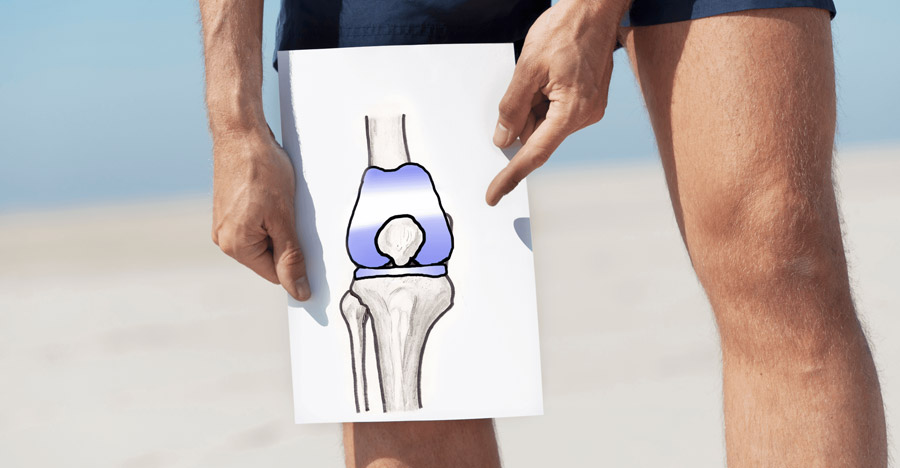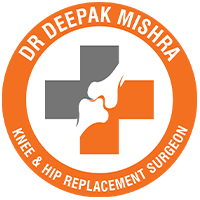
Partial Knee Replacement Surgery
Partial knee replacement surgery is a minimally invasive orthopedic procedure that replaces only the damaged portion of the knee joint, preserving healthy tissues. This approach provides faster recovery and improved natural movement compared to total knee replacement. Dr. Deepak Mishra, a leading orthopedic expert, is recognized as the best partial knee replacement surgeon for his expertise in advanced surgical techniques and patient care.
Who Needs Partial Knee Replacement?
This surgery is ideal for patients with localized knee damage caused by arthritis or injury. Candidates for partial knee replacement often exhibit:
- Common Causes:
- Osteoarthritis affecting only one part of the knee joint.
- Knee injuries leading to cartilage loss in specific areas.
- Key Symptoms:
- Pain in the inner or outer knee compartment.
- Stiffness and difficulty with daily activities like walking or climbing stairs.
- Swelling that worsens after physical activity or rest.
- Eligibility Criteria:
- Patients with arthritis confined to one or two compartments.
- Healthy knee ligaments with minimal joint damage.
- No relief from physiotherapy, medications, or other conservative treatments.
Why Choose Dr. Deepak Mishra for Partial Knee Replacement?
Dr. Deepak Mishra has a reputation for successful partial knee replacements with excellent outcomes. His approach focuses on personalized care, from pre-operative evaluations to post-surgical recovery, ensuring every patient achieves the best possible mobility.
- Expertise in minimally invasive knee surgery.
- Over 20 years of experience in orthopedic procedures.
- A patient-centric approach with emphasis on fast recovery and reduced complications.
Benefits of Partial Knee Replacement Surgery
Many patients prefer partial knee replacement due to several benefits:
- Faster recovery: The minimally invasive technique leads to quicker rehabilitation.
- Natural movement: Healthy knee tissues are preserved, enhancing post-surgery mobility.
- Lower complication risks: Smaller incisions reduce the chance of infection and blood clots.
- Less postoperative pain: Results in faster return to normal activities.
Types of Partial Knee Replacement Procedures
Dr. Deepak Mishra specializes in various types of partial knee replacements based on individual patient needs:
- Unicompartmental Replacement: Replaces the inner (medial) or outer (lateral) knee compartment.
- Patellofemoral Replacement: Focuses on the knee cap and surrounding structures.
- Bicompartmental Replacement: Involves replacing two out of three knee compartments to relieve pain and restore function.
The Surgery Process: What to Expect
1. Pre-operative Preparations:
- A complete evaluation using X-rays and MRIs to assess knee health.
- Dr. Mishra explains the surgical plan and addresses patient concerns.
- Pre-surgical counseling to optimize recovery outcomes.
2. The Surgery:
- Surgery performed under general or spinal anesthesia.
- Dr. Mishra makes a small incision to access the damaged compartment.
- The damaged tissue is replaced with a prosthetic implant.
- The incision is closed, followed by careful post-operative monitoring.
3. Post-surgical Recovery:
- A short hospital stay, with some patients returning home on the same day.
- A rehabilitation program tailored to the patient’s progress.
- Dr. Mishra provides follow-up care to monitor recovery and adjust the physiotherapy plan as needed.
Risks and Potential Complications
Though complications are rare under the care of Dr. Deepak Mishra, it is important to be aware of possible risks:
- Infection or swelling at the incision site.
- Blood clot formation in the legs post-surgery.
- Prosthetic wear or loosening over time.
- Persistent knee pain or stiffness.
- The need for a future total knee replacement if arthritis progresses.
Recovery Timeline and Rehabilitation
Phases of Recovery:
- First 48 hours: Initial rest and gentle movement exercises.
- 2–6 weeks: Progressive rehabilitation with physiotherapy to restore strength.
- 3–6 months: Patients regain mobility and return to normal activities.
Tips for Faster Recovery:
- Follow the personalized physiotherapy plan prescribed by Dr. Mishra.
- Avoid strenuous activities and maintain a healthy weight to reduce joint stress.
- Consume a nutritious diet to promote joint healing.
Success Rates and Longevity of Partial Knee Replacement
Dr. Mishra’s patients report high satisfaction and significant improvement in mobility. With proper care, the implant can last for 10–15 years or more. Adopting an active lifestyle, while avoiding high-impact activities, further extends the life of the implant.
Cost and Insurance Coverage
The cost of partial knee replacement varies based on several factors, including:
- Hospital fees and the surgeon’s expertise.
- Type and quality of the prosthetic used.
- Pre-surgical evaluations and post-operative care requirements.
Dr. Mishra’s team works closely with insurance providers to help patients understand their coverage and manage costs effectively.
Choosing Dr. Deepak Mishra as Your Surgeon
Patients consistently recommend Dr. Mishra for his expertise and compassionate care. Choosing the right surgeon is critical to achieving the best results, and Dr. Mishra ensures that each patient receives a tailored treatment plan.
Comparing Partial vs. Total Knee Replacement
Partial knee replacement offers several advantages:
- Less invasive: Faster recovery with fewer complications.
- Preserves natural movement: Keeps healthy parts of the knee intact.
- Lower overall cost: Fewer hospital stays and quicker return to work.
However, if arthritis affects the entire knee, total knee replacement may be more appropriate.
Patient Testimonials and Case Studies
- Mrs. Anjali Singh: After undergoing unicompartmental replacement with Dr. Mishra, Mrs. Singh regained mobility within weeks. She now enjoys daily walks without pain.
- Mr. Rajesh Verma: As an avid runner, Mr. Verma opted for a patellofemoral replacement. Dr. Mishra’s expertise helped him recover fully and return to jogging within six months.
Frequently Asked Questions (FAQs)
- How long does the surgery take?
Typically, it takes 1–2 hours. - When can I drive after the procedure?
Most patients resume driving within 4–6 weeks. - Can both knees be operated on at once?
It depends on the patient’s health and the surgeon’s recommendation. - What activities should I avoid post-surgery?
High-impact activities such as running should be avoided to protect the implant.
Conclusion: Making the Right Choice
Partial knee replacement is an effective option for patients with localized knee damage. With the expertise of Dr. Deepak Mishra, the best partial knee replacement surgeon, patients can expect superior results and a smooth recovery process. If knee pain is affecting your quality of life, schedule a consultation with Dr. Mishra to explore if partial knee replacement is the right choice for you.
This detailed content ensures your website provides valuable, patient-centric information, helping individuals make informed decisions about partial knee replacement surgery under the expert care of Dr. Deepak Mishra.
Partial knee replacements is indicated for those patients in whom only one compartment of knee joint is affected by arthritis. The knee joint is divided into three compartments – medial, lateral and patellofemoral. Partial knee replacement for medial compartment of knee has been successfully performed worldwide. In recent times, partial replacement of the patella-femoral joint is also gaining popularity. Patients who suffer with inflammatory arthritis, knee stiffness, ligamentous injury or arthritis in more than one compartment are not suitable candidate for this procedure.
Partial knee replacement is performed through much smaller skin incision than for total knee replacement surgery. As only part of the knee is replaced, patients feels it more natural. Lesser post-operative pain and “natural feeling” helps in quicker rehabilitation and recovery after the surgery. Patients return to their normal activities sooner.
